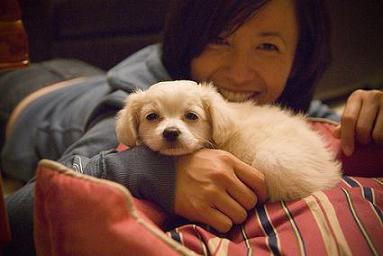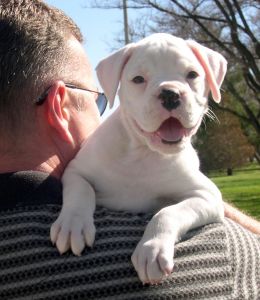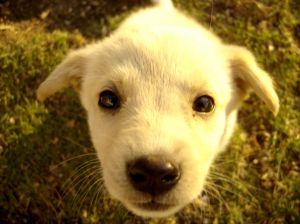Tuesday, August 21, 2012
Saturday, July 24, 2010
World’s first ice cream truck for dogs rolls out

LONDON — The world's first ice cream van for dogs will open for business at a "pet party" in London's Regent's Park on Saturday.
The van will serve canine-friendly flavors such as "Dog Eat Hog World" — a chicken and gammon sorbet — and "Canine Cookie Crunch," a more traditional vanilla ice cream, albeit sprinkled with dog biscuits.
"The weather has been so hot, we thought dogs deserved a cooling treat as much as anyone else," said Sally Bezant of event organizer Boomerang Pets Party.
She said a team of pet nutritionists had been through a complicated scientific process to determine the tastiest and safest flavors for the dogs' dessert.
And although the unusual flavors were tested on a panel of dogs, they can be eaten by humans.
"It's safe for humans ... I've tried it myself," she told Reuters, adding, perhaps diplomatically, that doggie ice-cream tasted "different."
Thursday, December 10, 2009
Monday, November 30, 2009
Tuesday, September 1, 2009
Friday, August 14, 2009
Puppy Socialization
What Is Puppy Socialization Anyway?
When people talk about puppy socialization they are generally referring to the first 16 weeks of a dog's life. This is the window of time in our puppy's lives that determines who they will become as adult dogs.The temperament, character and behavior habits of your puppy are developed during this socialization period - and will last a lifetime. It affects how your puppy will relate to his family, strangers, animals and the environment in which he lives.
Puppy socialization stimulates the five senses of your young dog. It is the introduction, exposure and desensitization to the sights, sounds, smells, tastes and touch of everyday life. The socialization period conditions your puppy to the many different situations he needs to be familiar with and comfortable around. It also prepares him to deal with the new experiences and challenges which inevitably arise throughout life in an appropriate manner.
Puppy socialization is the crucial stage where you begin to build the close bond you share with your dog, one that will last forever. It's up to you - any puppy can become a well adjusted and trusted member of society through proper socialization.
We owe it to our puppies to provide them with thorough socialization and training - all dogs need to be socialized regardless of breed type, where you bought the puppy from or anything else you may think of.
There are two main types of puppy socialization:
Active - Things we purposely introduce to our dogs like obedience training, visiting new people and rides in the car.
Passive - What your puppy comes across in her own time like exploring the plants in the back yard.
Note: Always check with your Veterinarian prior to starting your puppy socialization. Socializing your puppy is a balancing act between the need for your puppy's education and experience against the necessity of safeguarding him from disease.

Why Is It So Important To Socialize Our Puppies?
- The puppy socialization period (especially the first 16 weeks) is the most critical time for shaping your dog's future temperament, character and behavior habits. If you miss out on socializing your puppy during this period you cannot simply go back and fix the problems later.
- Preventing problem behaviors through proper socialization is a much more attractive alternative than trying to correct the undesirable behavior (barking, object guarding, chewing, separation anxiety, dog to dog aggression etc.) that arises from a lack of socialization.
- Puppy socialization is an essential ingredient in building and strengthening the bond you will share with your dog throughout his life. The time you put in now will be well rewarded.
Unsocialized Puppies Take A Very Different Path In Life Than A Dog Who Is Properly Socialized
- Socializing your puppy has an even bigger influence over her behavior than the breed of dog (boxer, beagle etc.) she is - it's that important.
- A socialized puppy is well placed to think, learn and problem solve (including obedience training), where's a fearful stressed dog (unsocialized) is severely restricted in this area.
- A well socialized dog will happily accept change, new people, challenges and will interact appropriately with other animals.
- Puppy socialization prepares your puppy for the hustle and bustle of everyday life. Things like the vacuum cleaner, dishwasher, lawn mower, cats, TV and whatever else life throws at him.
- Puppy socialization educates your dog about appropriate social interaction and how to inhibit aggression towards people and other animals.
- Socialization feeds all of the senses and safely, positively promotes emotional and mental stimulation.
What Happens If You Don't Properly Socialize Your Puppy?
- An unfortunate but undeniable fact is that the number one reason why dogs end up being euthanized is through a lack of socialization (from the associated problems that arise). The sad part is that socializing your puppy isn't really that difficult.
- If you miss the crucial puppy socialization period it's not something you can catch up on later - you have deadlines you must meet!
- You end up with a dog that is an outcast to society, one that doesn't fit in and can't be trusted. Sadly there are many dogs in this very situation living out their days permanently confined to the back yard.
- Dogs who miss the critical socialization period often exhibit shyness, aggression, timidity, fear towards people, dogs and other animals. They are also often inept at relating with other dogs.
- If your puppy is deprived of early social stimulation the result is her physical and emotional health can be irreversibly compromised.
- Unexpected events and new experiences are not well received by unsocialized dogs. What we strive for in our dogs is a happy balance between them being cautious and having the confidence to accept and explore new things.
When Does The Puppy Socialization Period Begin?
Pretty much the moment your puppy comes into this world the socialization and habituation window is open.
1. The mother of your pup begins the socialization process through massaging your puppy with her tongue to control his elimination, also through sound, smell and body language. She is also responsible for giving your puppy his first lesson in discipline.
2. Litter mates (siblings) learn from each other through play time and social interaction. They discover many aspects of being a dog including how to inhibit their bite and also the language of dominance and submission.
3. The breeder plays a crucial role in the first 7-8 weeks of your puppy's life. He/she should handle the puppies during this critical period, getting them used to human scent and touch. A good breeder will also begin to get your puppy accustomed to proper household etiquette, noises and basic training.
How Do I Socialize My Puppy?
Ideally at about the 8 week mark your puppy will arrive at your home, which will be his home for life. Your responsibility to provide him proper socialization starts immediately, you're in control, it's in your hands. This is the beginning of the primary socialization window - make the most of it!
Note: Avoid any situations during this first couple of weeks at home that will scare your puppy (often called the fear impact period). Any major scare (like an aggressive dog approaching) can emotionally damage your pup forever.
* Puppy house training, crate training and chew toy training should commence as soon as your new housemate arrives. This is all part of the puppy socialization process, it establishes proper household etiquette, reinforces desirable behavior and prevents bad habits from forming.
* Pick your puppy up, stroke her belly, touch her all over while gently talking to her. Also invite other people to do the same.
* For your dog's safety and to establish a close bond it's important to begin some obedience training right away. Teach some basic commands such as sit, down, stay and the recall. This do it yourself training package will show you how to do it the right way yourself at home - Secrets To Dog Training.
* Involve your new puppy in everything you can (isn't this why you got your puppy in the first place?), always under close supervision. Just get her familiar and comfortable with all of the daily routines and happenings of her new household. This is her environment now, we want her to be relaxed and comfortable around things like the vacuum cleaner, dishwasher, TV and noisy children.
* It's essential that your puppy meets as many people as possible before he reaches 12 weeks of age. As his vaccinations won't be completed by this stage, it's best if the people come to him. Always make visits a fun, non-threatening experience for your little pup. Encourage play, treats and touch between your visitors and your puppy. If you're game you can also visit some friends with immunized and trustworthy cats or dogs.
* Groom your dog, bathe her and clip her nails.
* Allow your puppy to explore your home, inside and out. Continue to supervise him but allow him to check things (pot plants, lawn mower, toys etc.) out for himself.
* Take your puppy for a boat ride, in an elevator or to the Vet. Anywhere you expect he may need to go as an adult you should expose him to it now - in a safe, non threatening and controlled fashion.
* Give your puppy some new toys and play some games with him. Anything that stimulates his mind and makes him problem solve is brilliant for his development. You can play games of hide and seek or build some obstacle courses for him to navigate his way through.
* Take your puppy with you on short car trips. Visit some friends or sit at the train station and watch some trains roll by. I don't recommend off leash dog parks as it's hard to know which dogs are vaccinated and of sound temperament. As I mentioned earlier a bad experience during the socialization period can scar your puppy for life.
* Once the final canine vaccination shots are done it is a great idea to get along to a good puppy kindergarten. Your puppy will continue to develop her social skills (bite inhibition) in a friendly and safe environment.
* As soon as the final vaccinations are completed you can start to get out and about even more. Take your puppy on walks to meet with other dogs, cats and other animals. Also encourage people to come up and pet your puppy while on walks. I still like to avoid off leash dog parks - they're too risky for my liking.
puppy socializing
Apart from all of the puppy socialization tips listed above it's important to remember to always have fun with it. Puppy socialization is a fun time, you'll get great pleasure out of watching your pup experience new things for the first time. Enjoy it.
Friday, July 24, 2009
Potty Training Your Puppy
Follow This Proven Potty Training Method
Waggs to Riches - The arrival of a new puppy is cause for great excitement in any household. It soon becomes clearly apparent that puppy house training is an urgent priority and the number one thing to teach our new housemates.
You'll find lots of puppy house training articles and theories across the net and in books everywhere, but I'm pleased to say that I've got a method that has never let me down. The potty training technique I have come to rely on and trust requires a fair degree of commitment to begin with but the rewards are quick and last forever. My veterinarian first told me about this potty training method which could be summed up as follows:
Puppy House Training - General Rules
- Owning a puppy is a big commitment for all family members, especially in the first few days and weeks.
- Puppy potty training is not a race, the key is to prevent mistakes and establish good habits early - dogs are creatures of habit.

- From your dogs point of view there is no right or wrong place to go to the toilet, they feel like going and just do it. It is our job to clearly communicate and reinforce where it is acceptable to eliminate and also where it is not acceptable.
- Opening your back door every couple of hours to let your puppy out will not house train your puppy.
- A puppy's natural instinct is to keep their bedding/sleeping area clean - the potty training method outlined below utilizes this knowledge to our advantage.
- No matter how attentive and diligent you are in the house training process there is bound to be the odd slip up. Don't worry about it just ensure that you clean mistakes up thoroughly, including the use of an odor neutralizer to take away any lingering smell.
- My puppy house training strategy involves close supervision and confinement to start with but only so we can allow our puppies greater freedom and much sooner.
- Understand your puppy's capabilities and be realistic, keep in mind you are dealing with a very young animal. Young puppies can only hold on for so long before they need to go, they don't have much control early on. As a general rule a puppy can hold on an hour for every month of his/her age, plus another hour. This means that a 2 month old puppy can be expected to hold on for three hours and at 3 months old this same pup could be expected to hold on for four hours at a time.
- Develop a food and water schedule. Each day feed at the same time (never close to bed time) and take away your dogs water bowl before you go to bed (don't forget to put it back first thing in the morning!). You'll develop a routine this way and "what goes in on schedule comes out on schedule", if you know what I mean...
Physical Punishment Is Never An
Option In The House Training Process!

Puppy House Training - Step by Step Process
This method is for when you are at home with your puppy, follow it as closely as you possibly can.Equipment you'll need:
I prefer to use a good quality crate. Ensure that it is comfortable, safe and the right dimensions for your puppy.
|
In addition to your 60 minute schedule it is important to take your puppy outside after each meal time (most puppies go to the potty within 15 minutes of eating).
That's the puppy house training process, follow it consistently and I'm sure you'll experience pleasing results. When you are not home you will need to set up an area with comfortable bedding, water, toys and a toilet. Place the indoor doggy toilet at the opposite side to the bedding in your puppy's living area. When you arrive home remove the toilet area inside and follow the potty training method detailed above.

Puppy House Training Process - Teaching Your Puppy To "ask" To Go Outside
If you aren't able to install a doggy door it is handy if you teach your dog the right way to let you know he wants to go outside. Do this by hanging a Poochie-Bell on a piece of string attached to the door handle (at the level of your puppy's nose).- Follow the puppy house training schedule as detailed above but now add the following: Each time you get to the door to go outside give the bell a bit of a shake and say "go potty". Do this every time you take your puppy outside to the toilet for a week or two.
- After a week or so when you arrive at the door say "go potty" but don't touch the bell. You want your puppy to give it a nudge, if he does, give lots of enthusiastic praise and quickly open the door. If your puppy doesn't nudge the bell after standing at the door for 10 seconds, shake the bell yourself while saying "go potty".
- Keep trying this procedure every time you go outside until your dog "gets it". With most dogs it doesn't take long at all.
- Eventually your dog will make his way to the door and tap the bell every time he needs to go outside to the toilet.
Teach Your Dog when & where to Go to the Bathroom -- powered by ExpertVillage.com





